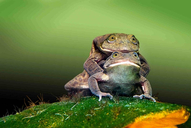|
Telmatobius hintoni Parker, 1940
| family: Telmatobiidae genus: Telmatobius |
| Species Description: De la Riva I 2006 Bolivian frogs of the genus Telmatobius (Anura: Leptodactylidae): synopsis, taxonomic comments, and description of a new species. In: E. O. Lavilla and I. De la Riva, (eds.), Studies on the Andean Frogs of the Genera Telmatobius and Batrachophrynus, pp. 65-101. Asociacion Herpetologica Espanola, Monografias de Herpetologia 7, Valencia. | |
 © 2014 Arturo Munoz (1 of 2) |
|
|
|
Distribution and Habitat Country distribution from AmphibiaWeb's database: Bolivia
Comments Telmatobius frogs, famous for their wrinkled appearance, are semi-aquatic or aquatic frogs that live at relatively high altitudes in the Andean regions of South America and are of extreme conservation concern due to habitat loss, infectious diseases (e.g., chytrid), and human predation (species in this group are believed to have medicinal properties and are regularly sold for consumption). A recent report on the ecology and evolution of parental care, Brunetti et al (2025) made observations of multiple species (T. culeus, T. hintoni, T. intermedius, T. jelskyii, and T. oxycephalus) in both the field and the lab. The most extensive observations (both intensity and duration) were made on wild and captive T. culeus from Lake Titicaca. They found that all these species exhibit male parental care in the form of clutch attendance and guarding (e.g. attacks on other individuals approaching the clutch). Given that the studied species are distributed widely across the phylogeny of Telmatobius, this suggests that parental care of aquatic eggs is likely a primitive trait within this clade. Their observations revealed several interesting aspects of parental care in these frogs. The authors were able to observe mating and oviposition in both the field and lab in several species. They found that eggs were attached to substrates (e.g. rocks or vegetation) underwater in each of the species. Several stream-breeding species were nocturnal, active only at night, whereas T. culeus from Lake Titicaca were active both day and night. The males frequently vocalized, and T. hintoni and T. oxycephalus males engaged in territorial aggression above and beyond the aggression associated with clutch guarding. The authors suggest that possibly territoriality and and parental care are linked to mating success in male Telmatobius (as in other taxa), but further research is needed to confirm or refute this. (Written by Kyle Summers) Edited by: Michelle S. Koo (2025-06-01) Species Account Citation: AmphibiaWeb 2025 Telmatobius hintoni <https://amphibiaweb.org/species/6734> University of California, Berkeley, CA, USA. Accessed Jun 2, 2025.
Feedback or comments about this page.
Citation: AmphibiaWeb. 2025. <https://amphibiaweb.org> University of California, Berkeley, CA, USA. Accessed 2 Jun 2025. AmphibiaWeb's policy on data use. |




 Map of Life
Map of Life